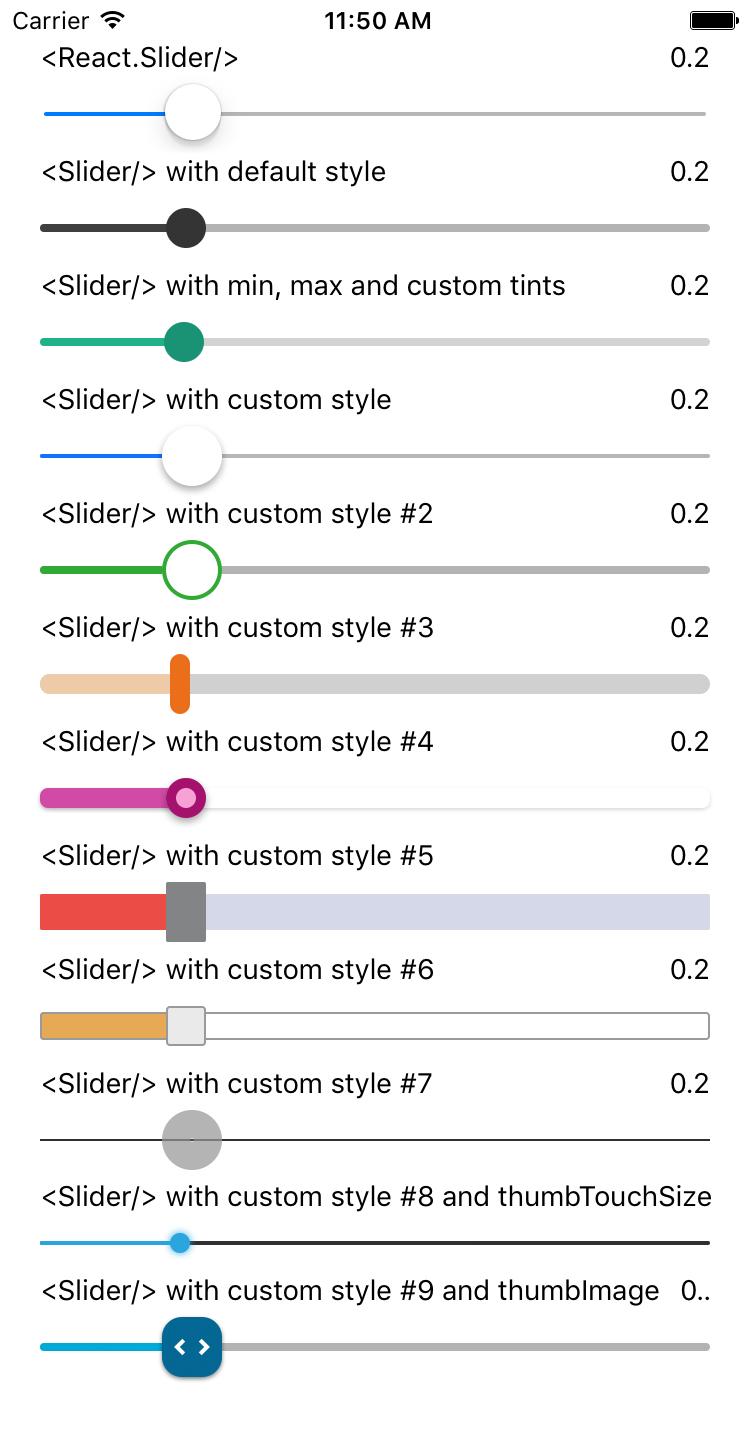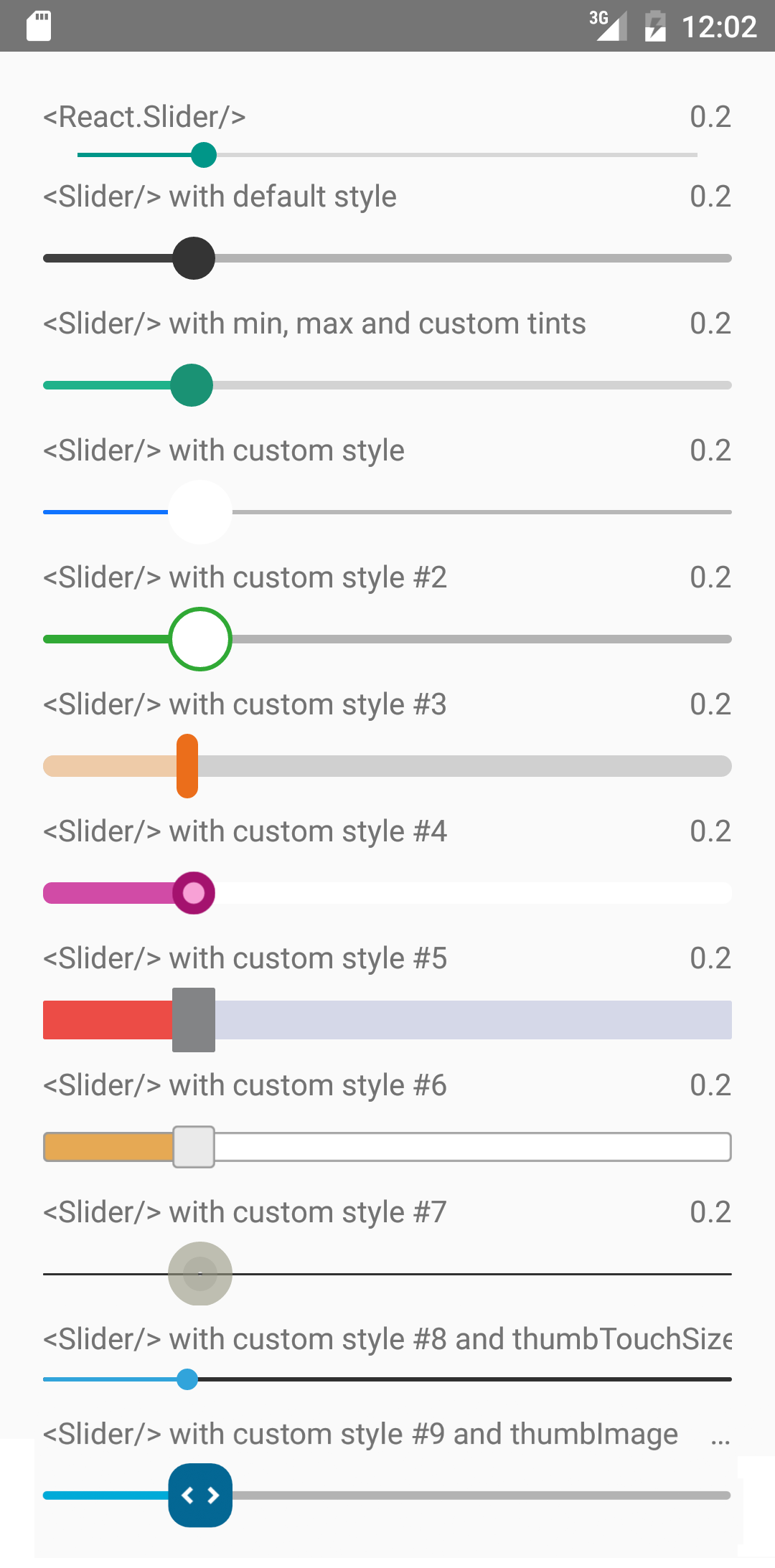A react-native-gesture-handler smoothed <Slider /> , also support trackImage and vertical.
It is a drop-in replacement for Slider.
npm i --save react-native-smooth-sliderAnd need install react-native-gesture-handler (1.1.0+ e.g. 1.2.2 for RN 0.57.2+ , or latest for RN 0.60.0+) by yourself.
import React from "react";
import Slider from "react-native-smooth-slider";
import { AppRegistry, StyleSheet, View, Text } from "react-native";
class SliderExample extends React.Component {
state = {
value: 0.2
};
render() {
return (
<View style={styles.container}>
<Slider
value={this.state.value}
onValueChange={value => this.setState({ value })}
/>
<Text>
Value: {this.state.value}
</Text>
</View>
);
}
}
const styles = StyleSheet.create({
container: {
flex: 1,
marginLeft: 10,
marginRight: 10,
alignItems: "stretch",
justifyContent: "center"
}
});
AppRegistry.registerComponent("SliderExample", () => SliderExample);| Prop | Type | Optional | Default | Description |
|---|---|---|---|---|
| value | number | Yes | 0 | Initial value of the slider |
| disabled | bool | Yes | false | If true the user won't be able to move the slider |
| minimumValue | number | Yes | 0 | Initial minimum value of the slider |
| maximumValue | number | Yes | 1 | Initial maximum value of the slider |
| step | number | Yes | 0 | Step value of the slider. The value should be between 0 and maximumValue - minimumValue) |
| minimumTrackTintColor | string | Yes | '#3f3f3f' | The color used for the track to the left of the button |
| maximumTrackTintColor | string | Yes | '#b3b3b3' | The color used for the track to the right of the button |
| thumbTintColor | string | Yes | '#343434' | The color used for the thumb |
| thumbTouchSize | object | Yes | {width: 40, height: 40} |
The size of the touch area that allows moving the thumb. The touch area has the same center as the visible thumb. This allows to have a visually small thumb while still allowing the user to move it easily. |
| moveVelocityThreshold | number | Yes | 2000 | Prevent onValueChange if velocityX or velocityY (vertical is true) of nativeEvent is over the moveVelocityThreshold |
| onValueChange | function | Yes | Callback continuously called while the user is dragging the slider and the dragging movement speed is below the moveVelocityThreshold | |
| onSlidingStart | function | Yes | Callback called when the user starts changing the value (e.g. when the slider is pressed) | |
| onSlidingComplete | function | Yes | Callback called when the user finishes changing the value (e.g. when the slider is released) | |
| style | style | Yes | The style applied to the slider container | |
| trackStyle | style | Yes | The style applied to the track | |
| trackImage | source | Yes | Sets an image for the track. | |
| thumbStyle | style | Yes | The style applied to the thumb | |
| thumbImage | source | Yes | Sets an image for the thumb. | |
| vertical | bool | Yes | false | Set this to true to be a vertical slider. |
| useNativeDriver | bool | Yes | false | The useNativeDriver parameter in Animated used by react-native-gesture-handler when the user change the value. Default value is false, because some Android phone PanGestureHandler causes Animated Value to jump when using native driver |
| animateTransitions | bool | Yes | false | Set to true to animate values with default 'timing' animation type when value in next props is different. |
| animationType | string | Yes | 'timing' | Custom Animation type when value in next props is different. 'spring' or 'timing'. |
| animationConfig | object | Yes | undefined | Used to configure the animation parameters when value in next props is different. These are the same parameters in the Animated library. |
setValue(value)
In some use case e.g. "tension rod", it's more convenient to use method instead of prop to restore original positon of the tension rod. Below is a vertical tension rod example screenshot.
Alipay: [email protected]
ETH: 0xd02fa2738dcbba988904b5a9ef123f7a957dbb3e
MIT Licensed






